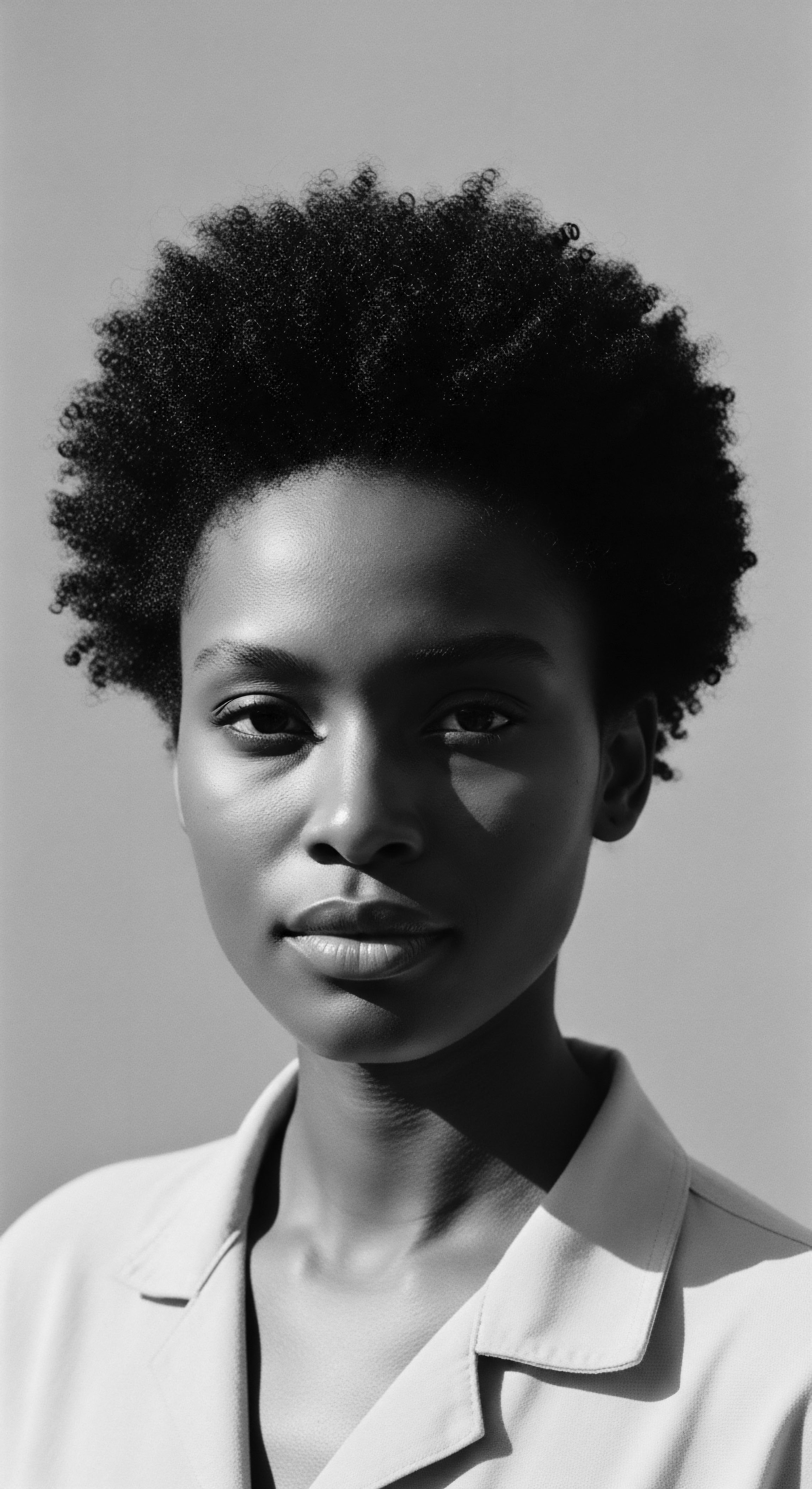
Fundamentals
Within Roothea’s living library, the meaning of Nutritional Science extends beyond mere biochemical processes; it is a profound exploration of how the sustenance we draw from the earth shapes the very strands that crown our heads, particularly those with Textured Hair. This field is the systematic study of nutrients and other substances in food, their action, interaction, and balance in relation to health and disease, and the processes by which the organism ingests, digests, absorbs, transports, utilizes, and excretes food substances. For our purposes, it is a lens through which we comprehend the foundational support required for the intricate structures of coils, curls, and waves.
Understanding this domain begins with recognizing that hair, a vibrant expression of our being, is not merely an external adornment. It is a biological extension, intricately tied to the body’s internal state. Every single strand of hair, from its deepest root within the scalp to its visible tip, is a testament to the body’s overall well-being. When the body receives the proper building blocks, hair responds with vitality and strength.
When these vital components are scarce, hair often shows the first signs of distress. This connection between internal nourishment and external manifestation holds particular resonance within the heritage of textured hair, where resilience and vitality have always been celebrated markers of health and identity.
The basic components of Nutritional Science for hair health are the macronutrients and micronutrients. Macronutrients, such as proteins, carbohydrates, and fats, provide the energy and structural elements needed for hair growth. Proteins, for instance, are the very foundation of hair, as strands are primarily composed of keratin, a protein.
Carbohydrates supply the energy for cellular activities, including those in the hair follicle. Healthy fats, including essential fatty acids, contribute to scalp health and the luster of the hair itself.
Micronutrients, encompassing vitamins and minerals, serve as cofactors and regulators for countless biochemical reactions that influence hair follicle function and hair shaft integrity. These are the silent orchestrators, ensuring that the larger building blocks are properly utilized. A deficiency in even one key micronutrient can disrupt the delicate balance required for robust hair growth.
Nutritional Science, in its simplest interpretation, is the study of how what we consume shapes the vitality and character of our hair, especially our textured strands.
From the earliest ancestral traditions, there was an intuitive recognition of this truth. Communities understood that robust health, often reflected in lustrous hair, sprang from a diet rich in local, seasonal foods. This ancestral wisdom, passed down through generations, often contained practical applications of what we now call Nutritional Science, even without the formal terminology. The emphasis was on holistic well-being, where the body, spirit, and environment were seen as interconnected, and food served as a central pillar in maintaining this delicate balance.

Intermediate
Delving deeper into Nutritional Science reveals its profound interplay with the intricate biology of hair, especially within the context of textured hair’s unique structure and heritage. This field moves beyond basic definitions to explore the specific roles of various nutrients in supporting the hair growth cycle, maintaining scalp health, and influencing the very integrity of the hair shaft. It acknowledges that hair is a rapidly regenerating tissue, second only to bone marrow in its growth rate, making it highly sensitive to the body’s nutritional status.
The hair follicle, the living part of the hair, is a miniature organ requiring a constant supply of energy and specific nutrients to perform its complex functions. These functions include cell proliferation, differentiation, and the production of keratin. The cyclical nature of hair growth, encompassing the Anagen (growth), Catagen (transitional), and Telogen (resting) phases, is highly dependent on a steady nutritional intake. Disruptions in this supply can lead to premature shedding, thinning, or alterations in hair texture.

The Role of Specific Nutrients for Textured Hair
Textured hair, with its unique coil and curl patterns, often presents distinct needs for moisture and strength. The helical structure of these strands means that natural oils produced by the scalp travel down the hair shaft with more difficulty, leading to a predisposition for dryness. Nutritional science plays a crucial role in addressing this.
- Proteins ❉ As the primary constituent of hair, adequate protein intake is non-negotiable. Without sufficient amino acids, the building blocks of protein, the body cannot produce strong keratin, leading to brittle, weak strands prone to breakage. Ancestral diets, rich in plant-based proteins from legumes, grains, and nuts, or lean animal proteins, historically provided this fundamental support.
- Iron ❉ A vital mineral for oxygen transport to hair follicles, iron deficiency is a common cause of hair thinning and loss. Women, particularly those with heavy menstrual cycles, may experience iron deficiency. Historical foodways often incorporated iron-rich greens and other plant sources, a wisdom that continues to hold value.
- Zinc ❉ This mineral is essential for cell division, protein synthesis, and maintaining the oil glands around the hair follicle, contributing to scalp health and hair luster. Zinc deficiency can manifest as dry, sparse, and brittle hair, potentially leading to hair loss.
- B Vitamins ❉ A complex family of vitamins, including biotin (B7), niacin (B3), and folate (B9), are critical for cellular metabolism and hair growth. Biotin, for instance, is often associated with hair strength, though deficiencies are uncommon. These vitamins are abundant in whole grains, leafy greens, and legumes, staples of many traditional diets.
- Vitamin D ❉ Beyond its role in bone health, Vitamin D influences hair follicle cycling and the creation of new hair follicles. Low levels have been linked to various forms of hair loss. Sunlight exposure, a historical constant, provided a natural source of this vitamin, though modern lifestyles may require other considerations.
- Omega-3 Fatty Acids ❉ These healthy fats, found in certain seeds, nuts, and fatty fish, contribute to scalp health, reducing inflammation and promoting hair density. They nourish the hair follicle and impart a natural sheen to the hair.
The hair follicle, a tiny marvel of biological activity, demands a precise symphony of nutrients to sustain the growth and vitality of every strand.

Echoes from the Source ❉ Ancestral Dietary Wisdom
The understanding of Nutritional Science, while a modern construct, finds deep resonance in the ancestral dietary practices of communities with textured hair. Long before laboratories isolated individual vitamins, traditional foodways provided comprehensive nutritional support for robust health, visibly reflected in the hair. The diets of many African communities, for example, were historically rich in plant-based foods, whole grains, and diverse protein sources. These dietary patterns naturally supplied the necessary elements for healthy hair.
Consider the emphasis on leafy greens, root vegetables, and legumes in many traditional African diets. These foods are veritable storehouses of vitamins, minerals, and antioxidants, all of which contribute to hair health. The use of traditional oils, such as palm oil or shea butter, in both diet and topical application, also played a role in nourishing the body and hair.
The wisdom was not just about what was eaten, but how. Communal meals, mindful preparation, and a connection to the source of food were integral parts of these practices, fostering a holistic approach to well-being that transcended mere caloric intake. This cultural embeddedness of nutrition meant that hair care was not a separate, superficial act, but an organic outcome of a life lived in harmony with the earth’s provisions.
This intermediate interpretation of Nutritional Science calls upon us to recognize the profound wisdom embedded in the food traditions of our forebears. It encourages a deeper look at the ingredients and culinary methods that sustained generations, allowing us to draw parallels between ancient practices and contemporary scientific understanding.

Academic
The academic elucidation of Nutritional Science, particularly when applied to the rich terrain of textured hair heritage, constitutes a sophisticated inquiry into the molecular, cellular, and systemic mechanisms by which dietary inputs influence hair biology and phenotypical expression. This definition moves beyond the simple correlation of nutrients and hair health, instead examining the complex physiological pathways, genetic predispositions, and epigenetic modifications that underpin the hair follicle’s response to nutritional status. It acknowledges that hair texture, while largely genetically determined, can be influenced by environmental factors, including nutrition.
At this advanced level, Nutritional Science is interpreted as the rigorous examination of nutrient bioavailability, metabolic pathways, and the systemic impact of dietary patterns on the intricate cellular machinery of the hair follicle. It encompasses the study of how deficiencies or excesses of specific micronutrients and macronutrients can perturb the hair growth cycle, alter keratinization, influence sebaceous gland activity, and contribute to inflammatory conditions of the scalp. The delineation extends to exploring the emerging understanding of the gut-hair axis, where the microbiome’s balance directly influences nutrient absorption and systemic inflammation, thereby affecting hair vitality.

The Gut-Hair Axis and Epigenetic Influence
Contemporary research highlights the significant role of the Gut Microbiome in overall health, including hair health. A balanced gut microbiome is crucial for the absorption of essential nutrients vital for hair, such as biotin, vitamin B12, zinc, selenium, and iron. Imbalances in the gut microbiota, termed dysbiosis, can lead to systemic inflammation and poor nutrient absorption, potentially contributing to various forms of hair loss, including autoimmune conditions like alopecia areata. This intricate connection underscores that true hair nourishment extends beyond mere dietary intake to encompass the body’s capacity to process and utilize those nutrients effectively.
Beyond direct nutrient supply, the field of Epigenetics offers a compelling dimension to Nutritional Science’s influence on hair. Epigenetics refers to heritable changes in gene expression that occur without altering the underlying DNA sequence. These modifications, which can turn genes “on” or “off,” are significantly influenced by environmental factors, including diet and stress.
Thus, nutritional deficiencies or imbalances can lead to altered epigenetic marks, affecting hair follicle development and growth, even for those with genetically predisposed hair types. This means that while genetic heritage provides the blueprint for textured hair, nutritional choices and environmental exposures can modulate how those genes are expressed throughout an individual’s lifetime.

A Historical Case Study ❉ The Nutritional Trauma of the Middle Passage and Plantation Diets
To truly appreciate the profound meaning of Nutritional Science in the context of textured hair heritage, one must confront the historical realities that profoundly impacted the nutritional status and hair health of enslaved Africans. The transatlantic slave trade and subsequent plantation systems represent a catastrophic disruption of ancestral foodways and a deliberate imposition of nutritional deprivation. This historical trauma provides a poignant, albeit difficult, case study in the devastating consequences of inadequate nutrition on the body, including hair.
Prior to forced migration, diets in many West African communities were diverse and nutrient-rich, incorporating a wide array of plant-based foods, whole grains like millet and sorghum, legumes, tubers, and various protein sources, often sourced locally. These traditional diets naturally provided the vitamins, minerals, and proteins necessary for robust health and, by extension, healthy hair. The hair care practices in these societies were often communal, involving natural ingredients and rituals that honored hair as a sacred aspect of identity.
Upon arrival in the Americas, enslaved Africans were subjected to diets that were monotonous, calorically insufficient, and severely lacking in essential nutrients. Common rations included cornmeal, salted pork, and molasses, a stark contrast to their diverse ancestral foods. This radical dietary shift, coupled with brutal labor conditions and psychological distress, led to widespread nutritional deficiencies. The impact on their bodies was severe, contributing to various health disparities that persist today.
The historical rupture of ancestral foodways for enslaved populations provides a stark illustration of how systemic nutritional deprivation can alter the very fabric of textured hair, transforming its resilience.
This forced dietary regimen directly affected hair health. Hair, as a non-essential tissue, is often one of the first parts of the body to show signs of nutritional distress. The lack of adequate protein, iron, zinc, and B vitamins would have led to ❉
- Weakened Strands ❉ Insufficient protein and amino acids would have resulted in weaker keratin bonds, making hair more brittle and prone to breakage.
- Altered Growth Patterns ❉ Deficiencies in key vitamins and minerals could have disrupted the hair growth cycle, leading to thinning and reduced length retention.
- Compromised Scalp Health ❉ A lack of essential fatty acids and vitamins could have contributed to dry, irritated scalps, further hindering healthy hair growth.
The aesthetic impact was significant. Hair that was once a source of pride, intricately styled and adorned, became matted, tangled, and often hidden under scarves, not solely due to lack of tools but also due to the internal degradation from malnutrition. This visible deterioration of hair was a tangible manifestation of the systemic nutritional violence inflicted upon enslaved peoples. The historical record, though sparse on direct scientific analyses of hair in this context, points to a clear degradation of physical health, of which hair would have been a direct indicator.
The ingenuity and resilience of enslaved Africans and their descendants, however, led to adaptations. They cultivated small gardens, incorporating traditional knowledge of plants, and adapted available ingredients to create what became “soul food.” While some adaptations, born of necessity, sometimes involved less nutritious components (e.g. fatty meats), the underlying impulse was to retain a connection to ancestral foodways and extract as much sustenance as possible from limited resources. This history underscores the critical importance of Nutritional Science not just as a field of study, but as a pathway to healing and reclaiming ancestral vitality for textured hair.
The contemporary legacy of this historical nutritional trauma is observed in ongoing health disparities within Black communities, including those related to diet-influenced conditions that can impact hair health. Understanding this historical context is not merely an academic exercise; it is a call to action for culturally informed nutritional interventions that honor ancestral wisdom while applying modern scientific insights. It invites a deeper appreciation for the resilience of textured hair, which, despite profound historical challenges, continues to be a vibrant symbol of heritage and identity.
| Traditional Ingredient Moringa (Moringa oleifera) |
| Key Nutrients for Hair Vitamins A, B, C; Iron, Zinc, Amino Acids |
| Hair Benefit (Heritage Link) Strengthens strands, reduces shedding, nourishes scalp; traditionally used as a superfood for overall vitality. |
| Traditional Ingredient Baobab Oil |
| Key Nutrients for Hair Vitamins A, D, E, F; Omega-3, -6, -9 Fatty Acids |
| Hair Benefit (Heritage Link) Moisturizes dry, brittle hair, strengthens weak strands, repairs split ends; used for centuries to protect hair in harsh climates. |
| Traditional Ingredient Shea Butter (Vitellaria paradoxa) |
| Key Nutrients for Hair Vitamins A, E, F; Fatty Acids |
| Hair Benefit (Heritage Link) Conditions hair, seals in moisture, protects against environmental damage; a staple for hair and skin care across West Africa. |
| Traditional Ingredient Black-Eyed Peas |
| Key Nutrients for Hair Folate, Iron, Protein, Zinc |
| Hair Benefit (Heritage Link) Supports hair growth, provides protein for keratin, aids in oxygen transport; a resilient crop, adapted and sustained through diasporic foodways. |
| Traditional Ingredient Sweet Potatoes |
| Key Nutrients for Hair Beta-carotene (Vitamin A precursor), Vitamin C, Iron |
| Hair Benefit (Heritage Link) Promotes cell growth, supports sebum production for moisture, provides antioxidants; a nutritious root vegetable common in ancestral diets. |
| Traditional Ingredient These traditional ingredients, deeply rooted in African and diasporic food systems, exemplify the ancestral understanding of food as medicine for the entire body, including hair. |

Reflection on the Heritage of Nutritional Science
The journey through Nutritional Science, viewed through the distinctive lens of textured hair heritage, reveals more than just biological mechanisms; it uncovers a profound connection to ancestral wisdom, resilience, and identity. Hair, for Black and mixed-race communities, has always been a living archive, a silent storyteller of journeys undertaken, challenges overcome, and traditions preserved. The vitality of each coil and curl often mirrors the vitality of the spirit and the body, intimately linked to the sustenance drawn from the earth.
From the echoes of ancient African foodways, rich with nutrient-dense plants and communal rituals, to the tender threads of care woven through generations of diaspora, Nutritional Science emerges as a foundational pillar. It reminds us that the quest for healthy hair is not a modern invention, but a continuation of a legacy, a re-engagement with the practices that sustained our forebears. The understanding that the nourishment we consume impacts the very fiber of our being, including our hair, is a truth as old as time itself.
The historical experiences of nutritional disruption, particularly those imposed by the transatlantic slave trade, stand as a powerful testament to the inseparable link between diet, health, and the visible manifestation of hair. Yet, even in the face of such profound challenges, the ingenuity and adaptive spirit of our ancestors shone through, as they found ways to cultivate sustenance and preserve practices that continued to nourish their bodies and souls. This enduring legacy inspires us to reclaim and honor the wisdom embedded in those food traditions.
Our hair, a living testament to generations, calls upon us to rediscover the nutritional wisdom that sustained our ancestors, allowing us to nourish our strands from a place of deep historical understanding.
Today, as we navigate a world of abundant information, the principles of Nutritional Science provide a bridge between ancient wisdom and contemporary understanding. They empower us to make informed choices that not only support the biological needs of our textured hair but also affirm our cultural identity and connection to a rich, enduring heritage. The unbound helix of textured hair, with its remarkable ability to adapt and flourish, serves as a powerful symbol of this continuous journey of self-discovery and ancestral reverence, inviting us to nourish ourselves holistically, from the inside out.

References
- Abbott Mihesuah, D. (2020). Recovering Our Ancestors’ Gardens ❉ Indigenous Recipes and Guide to Decolonized Eating. University of Nebraska Press.
- Davis-Sivasothy, A. (2011). The Science of Black Hair ❉ A Comprehensive Guide to Textured Hair Care. Sivasothy Hair, LLC.
- Kinard, T. (1997). No Lye! ❉ The African American Woman’s Guide to Natural Hair Care. St. Martin’s Griffin.
- Jacobs-Huey, L. (2006). From the Kitchen to the Parlor ❉ Language and Becoming in African American Women’s Hair Care. Oxford University Press.
- O’Connor, K. & Goldberg, L. J. (2021). Nutrition and hair. Clinics in Dermatology, 39(5), 723-731.
- Ajao, A. A. & Sadgrove, N. J. (2024). Cosmetopoeia of African Plants in Hair Treatment and Care ❉ Topical Nutrition and the Antidiabetic Connection? Diversity, 16(2), 99.
- Xie, Y. Chen, J. & Zhang, Y. (2022). The gut microbiome and Alopecia areata ❉ Implications for early diagnostic biomarkers and novel therapies. Frontiers in Immunology, 13, 977938.
- Smith, O. (2021). The Pursuit of Health Through Heritage — Exploring A Diet Rooted in African Traditions for Optimal Health. (Presentation at AHS21).
- Marmol, M. & Vales, M. (2018). Heavy is the Head ❉ Evolution of African Hair in America from the 17th c. to the 20th c. Library of Congress .
- Shiel, C. & Smith, J. (2022). Diet, Health and Beauty in Early Jamaica, 1700-1900. (Conference paper, ResearchGate).
